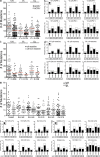Monoclonal IgG antibodies generated from joint-derived B cells of RA patients have a strong bias toward citrullinated autoantigen recognition
- PMID: 23440041
- PMCID: PMC3600900
- DOI: 10.1084/jem.20121486
Monoclonal IgG antibodies generated from joint-derived B cells of RA patients have a strong bias toward citrullinated autoantigen recognition
Retraction in
-
Retraction: Monoclonal IgG antibodies generated from joint-derived B cells of RA patients have a strong bias toward citrullinated autoantigen recognition.J Exp Med. 2019 Jan 7;216(1):245. doi: 10.1084/jem.2012148612112018r. Epub 2018 Dec 19. J Exp Med. 2019. PMID: 30567717 Free PMC article. No abstract available.
Abstract
Antibodies targeting citrullinated proteins (ACPAs [anticitrullinated protein antibodies]) are commonly found in patients with rheumatoid arthritis (RA), strongly associate with distinct HLA-DR alleles, and predict a more aggressive disease course as compared with seronegative patients. Still, many features of these antibodies, including their site of production and the extent of MHC class II-driven T cell help, remain unclarified. To address these questions, we have used a single B cell-based cloning technology to isolate and express immunoglobulin (Ig) genes from joint-derived B cells of active RA patients. We found ∼25% of synovial IgG-expressing B cells to be specific for citrullinated autoantigens in the investigated ACPA(+) RA patients, whereas such antibodies were not found in ACPA(-) patients. The citrulline-reactive monoclonal antibodies did not react with the unmodified arginine peptides, yet several reacted with more than one citrullinated antigen. A role for active antigen selection of the citrulline-reactive synovial B cells was supported by the strong bias toward amino acid replacement mutations in ACPA(+) antibodies and by their loss of reactivity to citrullinated autoantigens when somatic mutations were reverted to the corresponding germline sequences.
Figures




References
-
- Aletaha D., Neogi T., Silman A.J., Funovits J., Felson D.T., Bingham C.O., III, Birnbaum N.S., Burmester G.R., Bykerk V.P., Cohen M.D., et al. 2010. 2010 rheumatoid arthritis classification criteria: an American College of Rheumatology/European League Against Rheumatism collaborative initiative. Ann. Rheum. Dis. 69:1580–1588 10.1136/ard.2010.138461 - DOI - PubMed
-
- Arnett F.C., Edworthy S.M., Bloch D.A., McShane D.J., Fries J.F., Cooper N.S., Healey L.A., Kaplan S.R., Liang M.H., Luthra H.S., et al. 1988. The American Rheumatism Association 1987 revised criteria for the classification of rheumatoid arthritis. Arthritis Rheum. 31:315–324 10.1002/art.1780310302 - DOI - PubMed
Publication types
MeSH terms
Substances
Grants and funding
LinkOut - more resources
Full Text Sources
Other Literature Sources
Medical
Molecular Biology Databases
Research Materials

